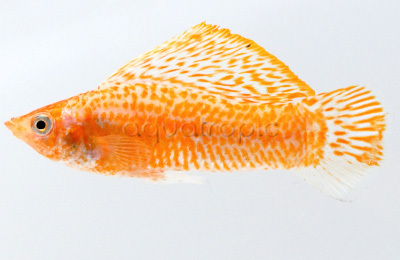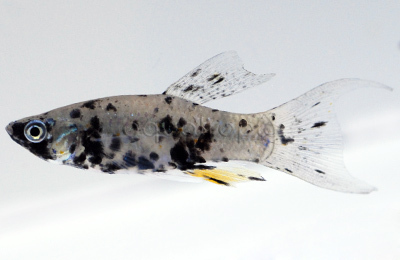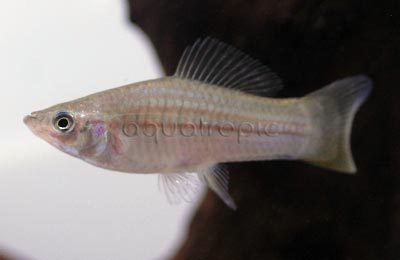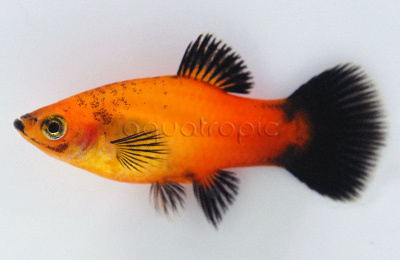How To Tell A Molly From A Platy

Livebearers are a perennial favorite among aquarists and for good reason. Thanks to their bright colors and the extreme ease with which they can be bred, there are now countless varieties that are regularly available: Red Wag, Mickey Mouse, Twin Bar, Golden Panda, Pineapple, etc. But how many actual species are there, and how can they be told apart? As it turns out, this is not always an easy question to answer.
Despite their impressive diversity of color and form, there are only around eight species that are commonly encountered in captivity (with many dozen more that are rarely seen or traded only among specialists). Of these, all are classified in either Poecilia or Xiphophorus. These two groups are among the most diverse in the livebearer family Poeciliidae, with 40 species and 28 species, respectively, but telling them apart can be a bit of a challenge. Some of these species are fairly distinctive thanks to their elaborate fins, but there are shorter-finned varieties in both genera which can be considerably more difficult to identify correctly.
Morphologists have split the livebearer family up in large part based on subtle differences in the shape of the male’s modified anal fin—the gonopodium. This is the structure used to internally fertilize females, and, because of its great evolutionary importance, this organ has been twisted into a variety of configurations. In Poecilia, the gonopodium is long and delicate, with a thin, fleshy protuberance that extends well beyond the fin rays. On the other hand, Xiphophorus lacks this fleshy bit entirely, having instead a recurved flange near the tip which resembles an arrowhead to some extent. These differences are easily seen with a microscope, but, alas, it is not as straightforward when examining a live fish, and, of course, this difference is of no help when looking at females.
But, aside from a couple shorter-finned species, these fishes can usually be told apart without to much difficulty. The biggest problem, as it relates to the strains available to aquarists, is that hybridization has been extensively employed to produce the many beautiful colors and patterns we have today.
Before we delve into where these fishes come from in the wild, let’s take a brief moment to address a nomenclatural question that many have. The common name “molly” comes from an older scientific name for the group, Mollienesia, which was, in turn, named in honor of an eighteenth century French financier and politician, Nicolas François, Count Mollien. The common name “platy” also comes from an older scientific name, Platypoecilus, which originates from the Greek for “flat, broad”.
Sailfin or Yucatan Molly (Poecilia velifera)

This is one of the easiest livebearers to recognize due to the enormous dorsal fin seen in males, though the females are considerably less endowed in their finnage and could potentially be confused with others. For either sex, counting the dorsal fin rays (16-20) is an easy way to confirm an identification. With a maximum size of six inches, this is one of the largest of the commonly available livebearers, and, for this reason, should be kept in suitably large accommodations, particularly if attempting to keep multiple males together. It’s occurs natively only along the coastal portions of the Yucatan Peninsula, in both fresh and brackish waters, but, like many of the species we’re discussing, it has also been introduced all over the world from aquarists who have released their pets into the wild.
Sailfin Molly (Poecilia latipinna)

This fish is the northern counterpart to P. velifera and occurs all along the Gulf Coast and up into North Carolina. The two sailfin mollies are very closely related and are told apart most easily by the lower dorsal fin count (13-16) in P.latipinna. In other respects, these two are quite similar as far as their husbandry requirements are concerned.
Mexican or Shortfin Mollies (Poecilia sphenops & P. mexicana)

The dorsal fin of these two species is considerably shorter than its sail-finned cousins, having only 9-10 rays and appearing longer than it is tall. Both occur widely across the eastern drainages of Mexico, with P. sphenops venturing as far south as Belize and Colombia. The wild populations of these can typically be told from one another easily enough just by examining the colors of the dorsal fin, but those available to aquarists generally look nothing like their wild forebears and are likely to have been hybridized extensively with each other and with the sailfin mollies. There is another key difference that allows for identification—the inner row of teeth in P. sphenops have three points, while those in P. mexicana have only one. But good luck examining that on a live fish!
Guppies (Poecilia reticulata and P. wingei)

Guppies are generally easily identified from the closely related mollies thanks to their painterly colors and the large fins which have been bred into many aquarium strains. But if you were to have a large female guppy right next to a female shortfin molly with its wild silvery coloration, the two could potentially prove challenging to tell apart. In this instance, the dorsal fin will once again prove informative, as guppies have an even shorter fin with only 7-8 rays. You’ll naturally find P. reticulata along the northern portions of South America, from Venezuela to Guyana, while Endler’s Guppy (P. wingei) is restricted exclusively to the Paria Peninsula of Venezuela. There has long been controversy over whether these two highly similar fishes are actually different species, but recent genetic studies have supported their differences. Telling the two apart, however, is not something that can be done reliably without knowing the exact geographic provenance of a specimen.
Green Swordtail (Xiphophorus helleri)

There is certainly no mistaking the male swordtail… unless somehow you miss the enormous extension which develops on the lower edge of the caudal fin. Like a peacock’s feathers, females use the relative length of this fin to determine which males are the healthiest to mate with. This is a widespread species in Central America, from Veracruz to Honduras. There are also several other closely related species in this region which are rarely available and difficult to tell apart. Many have much shorter “swords”, but one species, X. montezumae, has its fin even more exaggerated, being nearly as long as the fish’s entire body! Many of these species are incredibly rare, having very small distributions and thus being in serious danger of extinction. For some swordtails whose habitat is particularly imperilled, captive populations maintained by aquarists are vital to their continued existence.
Platies (Xiphophorus maculatus and X. variatus)

The platies belong to a separate evolutionary branch of Xiphophorus which has lost its “swordtail”. These two sister species occupy mostly non-overlapping ranges in Central America, with X. variatus found in central portions of Mexico and X. maculatus occurring further south into areas of Belize and Honduras. The two are not easily told apart, particularly those which occur in aquariums, as there are very few pure lineages for any of these fishes among commercial breeders. For the wild populations, X. variatus is said to have a somewhat more elongated body (similar to X. helleri), while X. maculatus is a bit stumpier in its proportions (though the true differences relate more to the shape of the gonopodium and their differing biogeography). There are also several other closely related species which have more restricted ranges in Mexico, but these are generally only available to specialist breeders.